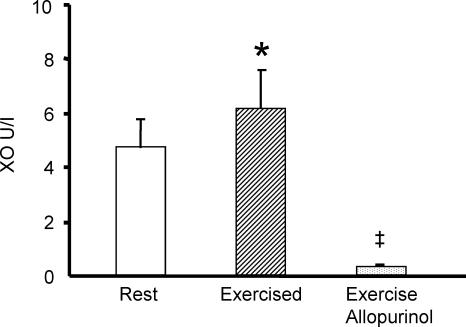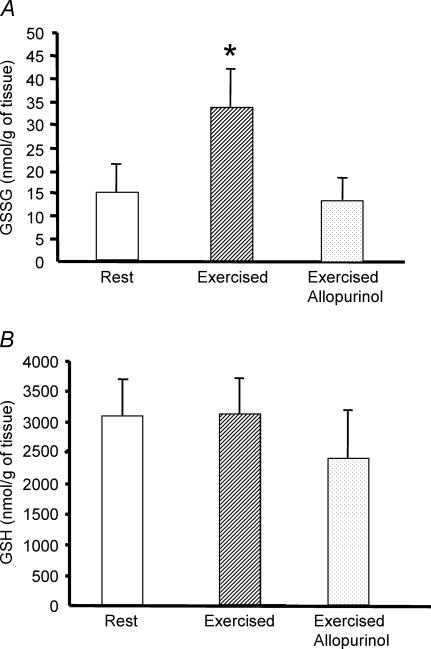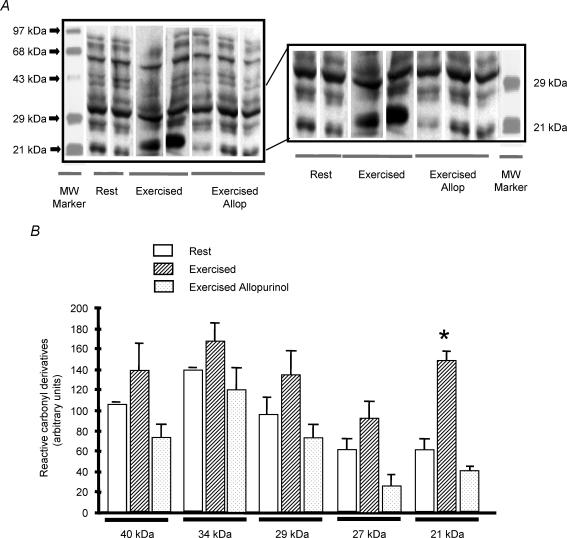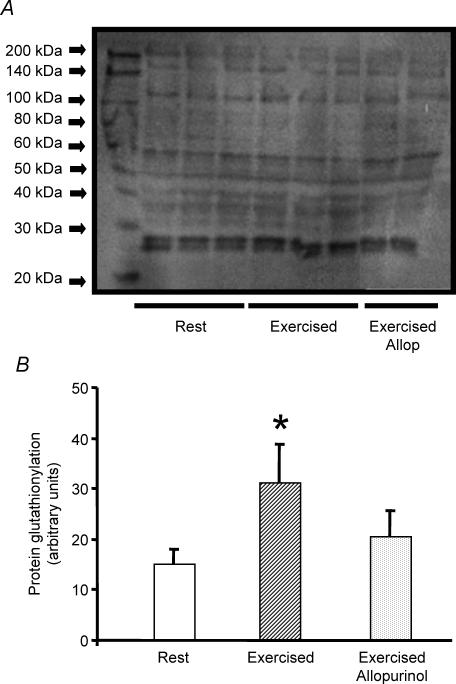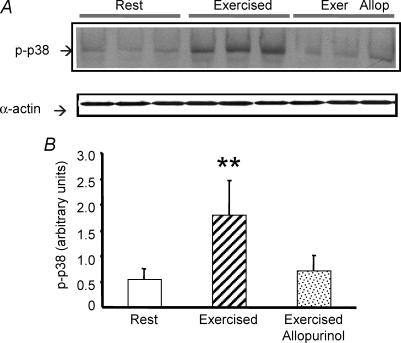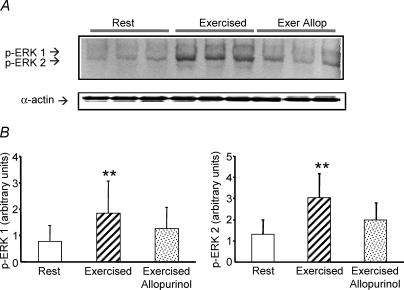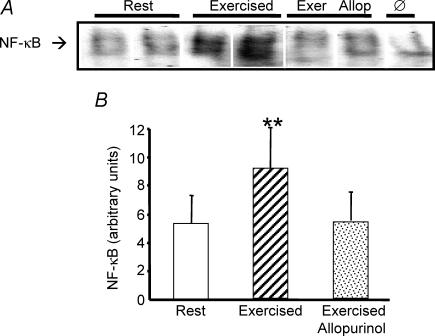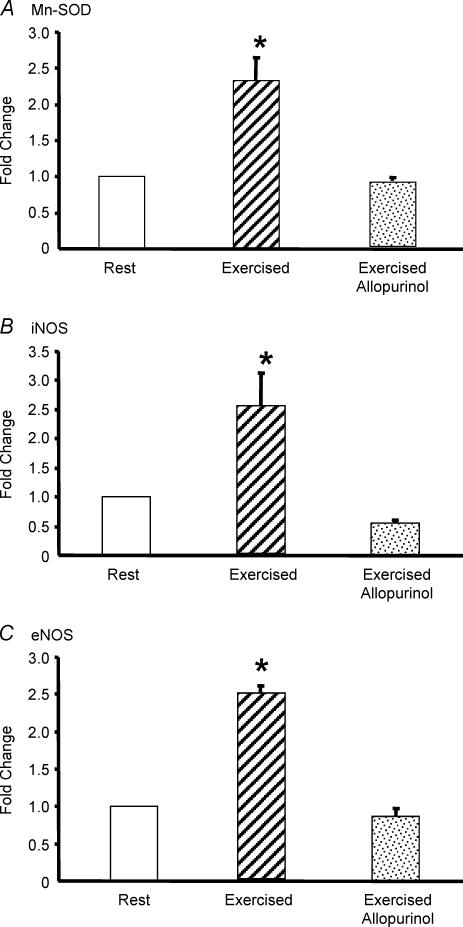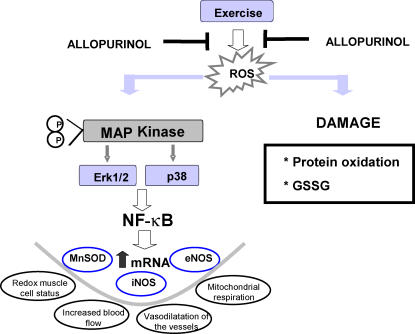Abstract
Reactive oxygen or nitrogen species (RONS) are produced during exercise due, at least in part, to the activation of xanthine oxidase. When exercise is exhaustive they cause tissue damage; however, they may also act as signals inducing specific cellular adaptations to exercise. We have tested this hypothesis by studying the effects of allopurinol-induced inhibition of RONS production on cell signalling pathways in rats submitted to exhaustive exercise. Exercise caused an activation of mitogen-activated protein kinases (MAPKs: p38, ERK 1 and ERK 2), which in turn activated nuclear factor κB (NF-κB) in rat gastrocnemius muscle. This up-regulated the expression of important enzymes associated with cell defence (superoxide dismutase) and adaptation to exercise (eNOS and iNOS). All these changes were abolished when RONS production was prevented by allopurinol. Thus we report, for the first time, evidence that decreasing RONS formation prevents activation of important signalling pathways, predominantly the MAPK–NF-κB pathway; consequently the practice of taking antioxidants before exercise may have to be re-evaluated.
Exercise causes an increase in the generation of free radicals by cells (Davies et al. 1982). We found that these radicals cause cellular damage only when exercise is exhaustive (Sastre et al. 1992). Strenuous exercise causes oxidation of glutathione, the release of cytosolic enzymes (Sastre et al. 1992), and other signs of cell damage (Jackson, 1987). This is prevented by antioxidant administration (Sastre et al. 1992).
We have recently reported that allopurinol protects against cell damage caused by exhaustive exercise both in humans (Gomez-Cabrera et al. 2003) and in experimental animals (Viña et al. 2000a) thus highlighting the role of xanthine oxidase (XO) in free radical generation during exercise.
However, free radicals not only cause damage but they also have a role in cell signalling (Reid et al. 1992; Jackson, 1999; Murrant & Reid, 2001). Moreover, the redox-sensitive transcription factor NF-κB is activated in exercise both in humans (Vider et al. 2001) and in animals (Hollander et al. 2001), leading to increased expression of superoxide dismutase (SOD), an enzyme involved in antioxidant defence (Ji et al. 2004).
In this paper we examine the role of RONS in generating signals that are important for cell adaptation to exercise in experimental animals. We report that RONS generated in exercise activate MAPKs, which in turn activate NF-κB which results in an increased expression of important cellular proteins such as iNOS, eNOS and Mn-SOD. Prevention of RONS formation by inhibition of XO abolishes these effects.
The practical implication is that decreasing RONS effects with antioxidants may hinder beneficial cell adaptations during exercise.
Methods
Animals
Twenty male Wistar rats were randomly divided into three groups: rest (n = 5), exercised (n = 5) and exercised but pretreated with 32 mg kg−1 of allopurinol by intraperitoneal (i.p.) injection (n = 5) (Viña et al. 2000b). The experimental protocol was approved by the Committee on Ethics in Research of the Faculty of Medicine, Valencia.
Exercise protocol
Rats were exercised until exhaustion following a modification of the protocol of Davies et al. (1982). Briefly, we used a progressive intensity treadmill test which consisted of an initial bout of 5 min at 11 m min−1 with consecutive 3 m min−1 increments every 5 min at a constant grade of 15%. Exhaustion was defined as the inability of a rat to right itself when being laid on its side. Control rats ran for 58 ± 7 min and allopurinol-treated rats ran for 55 ± 5 min (i.e. no difference).
Rats were anaesthetized with 50 mg kg−1 sodium pentobarbithal by i.p. injection, immediately after the exercise. Blood was obtained by venous puncture into heparin-containing tubes.
Gastrocnemius muscle was removed quickly, freeze-clamped immediately and stored at −80°C until used. Lactate was measured in the blood (Gutmann & Wahlefeld, 1974). Lactate levels were similar between the two exercised groups: controls, 7.5 ± 3.1 mmol l−1; allopurinol-treated, 7.9 ± 2.9 mmol l−1. Lactate levels at rest were 1.3 ± 0.4 mmol l−1.
Rats were killed by an overdose of the anaesthetic.
Determination of reduced glutathione and oxidized glutathione
Reduced glutathione (GSH) and oxidized glutathione (GSSG) levels were determined in muscle from rats by HPLC following the protocol described in Asensi et al. (1994).
Determination of XO activity
XO activity was measured in rat plasma by the fluorimetric method described in Beckman et al. (1989).
Electrophoretic mobility shift assay (EMSA)
The preparation of nuclear extracts was based on the method of Dignam et al. (1983) (with slight modifications, Hahn & Covault, 1990). The EMSA method was used to characterize the binding activities of the NF-κB transcription factor in nuclear extracts using the DIG Gel Shift Kit (Roche) as described by the manufacturer. The nuclear protein–digoxigenin-labelled oligonucleotide complexes were separated from free digoxigenin-labelled oligonucleotide by electrophoresis through 8% poly-acrilamide gels. Following the electrophoretic separation, the oligonucleotide–protein complexes were blotted onto positively charged nylon membranes using electroblotting. The digoxigenin-labelled probes were subsequently detected by an enzyme immunoassay using anti-digoxigenin alkaline phosphatase, Fab fragments and the chemiluminescent substrate CSPD (Roche Diagnostic). Detection of alkaline phosphatase was performed by autoradiography of the chemiluminescence produced during enzymatic dephosphorylation of CSPD. The chemiluminescent signals were recorded by exposure to X-ray film for 40–60 min.
Immunoblot analysis
Aliquots of muscle lysate (20–40 μg) were separated by SDS-PAGE electrophoresis. Proteins were then transferred to nitrocellulose membranes, which were incubated overnight at 4°C with the appropriate primary antibodies: phospho-p38, phospho-ERK1/2, α-actin (Cell Signalling Technology), anti-dinitrophenylhydrazone (Intergen Company), anti-Mn-SOD (Stressgen Biotechnologies Corp.) and anti-GSH IgG2a mouse monoclonal antibody (Virogen Watertown, MA, USA). The level of protein-glutathione adducts were identified using Western blot analysis under non-reducing conditions. Thereafter, membranes were incubated with a secondary antibody for 1 h at room temperature. Specific proteins were visualized by using the enhanced chemiluminescence (ECL) procedure as specified by the manufacturer (Amersham). Autoradiographic signals were assessed using a Bio-Rad scanning densitometer (Bio-Rad, Hercules, CA, USA).
Real-time reverse transcriptase–polymerase chain reaction (real-time RT-PCR)
RNA was isolated from rat muscles using the QuickPrep Total RNA extraction kit (Amersham Pharmacia Biotech) as described by the manufacturer. Quantitative real-time RT-PCR was performed using the Tth DNA polymerase kit (Roche Diagnostics-Boehringer Mannheim) as described by the manufacturer. Real-time quantification of the enzymes relative to glyceraldehyde-3-phosphate dehydrogenase (GAPDH) mRNA was performed with SYBR Green I assay, and evaluated using a iCycler detection system (Biorad, Hercules, CA, USA). The threshold cycle (Ct) was determined, and the relative gene expression was expressed as follows: fold change = 2 ^ (−ΔΔCt).
The specific primers used for Mn-superoxide dismutase were (5′ to 3′): CGTGCTCCCACACATCAATC and TGAACGTCACCGAGGAGAAG; for iNOS: TGTGACACACAGCGCTACAA and TGTTGAAGGCGTAGCTGAAC; for eNOS: CTGCTGCCCGAGATATCTTC and CTGGTACTGCAGTCCCTCCT and for the housekeeping gene, GAPDH: CCTGGAGAAACCTGCCAAGTATG and GGTCCTCAGTGTAGCCCAAGATG.
Statistics
Results are expressed as mean ±s.d. Statistical analysis was performed by the least-significant difference test which consists of two steps. First an analysis of variance was performed. The null hypothesis was accepted for all numbers of those sets in which F was non-significant at the level of P = 0.05. Second, the sets of data in which F was significant were examined by the modified t test using P = 0.05 as the critical limit.
For real-time RT-PCR statistical analysis, differences between means were analysed using one-way ANOVA. Tukey's multiple comparisons test for all pairs of columns was applied as a post hoc test. In all instances P < 0.05 was taken as an indication of significance. A commercial software package (Kaleida Graph 3.6 Software) was used to perform all statistical analyses.
Results
Exercise activates plasma XO: prevention by allopurinol
We used the rat as a model to check the effect of RONS generated by XO in oxidative stress and cell signalling during exercise.
Rat plasma XO activity increased after exercise (Fig. 1). Allopurinol completely prevented this effect. As shown in Fig. 2, exhaustive exercise caused muscle oxidative stress evidenced by oxidation of glutathione (Fig. 2A). Total GSH levels were not significantly changed (Fig. 2B). We also determined the muscle protein oxidation. A protein(s) with a molecular mass of 21 kDa was significantly oxidized in muscle of exercised rats (see Fig. 3A and B). Both protein and glutathione oxidation were prevented by treatment with allopurinol. Figure 4 shows the level of glutathionylated proteins in muscle before, after exercise, and after exercise plus treatment with allopurinol. Exercise increases the glutathionylation of proteins, in particular of a protein band of approximately 25 kDa. Allopurinol prevents such an increase.
Figure 1. Xanthine oxidase (XO) activity in rat plasma increases after exhaustive exercise; allopurinol administration completely prevents this effect.
Rest, n = 5; Exercised, n = 5; Exercised treated with allopurinol, n = 5. *P < 0.05 versus Rest. ‡P < 0.01 versus Exercised.
Figure 2. Muscle oxidative stress after exhaustive physical exercise in rats.
A, allopurinol prevents oxidation of glutathione (GSSG) in exhaustive exercise. Values are means ±s.d.; Rest, n = 5; Exercised, n = 4; Exercised treated with allopurinol, n = 4. *P < 0.05 versus Rest. B, reduced glutathione (GSH) muscle levels in exhaustive exercise. Values are means ±s.d.; Rest, n = 5; Exercised, n = 4; Exercised treated with allopurinol, n = 4.
Figure 3. Muscle protein oxidation after exhaustive physical exercise in rats.
A, Western blot showing carbonylated proteins in cytosolic extracts from gastrocnemius muscle. Representative experiments are shown. B, densitometry analysis of protein carbonylation. Values are means ±s.d.*P < 0.05 versus Rest.
Figure 4. Muscle protein glutathionylation after exhaustive physical exercise in rats.
A, Western blot showing glutathionylated proteins in cytosolic extracts from gastrocnemius muscle. Representative experiments are shown. B, densitometry analysis of protein glutathionylation. Values are means ±s.d.*P < 0.05 versus Rest.
Exercise-induced RONS activate MAP kinases
Exercise caused a significant, threefold increase in p38, ERK1 and ERK2 MAPKs phosphorylation. This was completely prevented following treatment with allopurinol (see Figs 5 and 6).
Figure 5. Exercise activates p38 phosphorylation: prevention by allopurinol.
A, Western blot analysis of phospho-p38 in the cytosolic fraction of rat gastrocnemius. B, densitometry analysis of p38 phosphorylation (n = 3). Values are means ±s.d.**P < 0.01 versus Rest.
Figure 6. Exercise activates ERK1/ERK2 phosphorylation: prevention by allopurinol.
A, Western blot analysis of phospho-ERK1/ERK2 in the cytosolic fraction of rat gastrocnemius. B, densitometry analysis of ERK1/ERK2 phosphorylation (n = 3). Values are means ±s.d.**P < 0.01 versus Rest.
RONS formed in exercise activate DNA binding of NF-κB in muscle
DNA binding of NF-κB is increased after exercise (Fig. 7). Figure 7A shows a representative experiment in which two samples are shown. Treatment with allopurinol prevents DNA binding of NF-κB. Figure 7B shows a densitometric measurement representing the mean ±s.d. of four experiments.
Figure 7. Exercise activates NF-κB: prevention by allopurinol.
A, EMSA analysis of NF-κB in the nuclear extracts of rat gastrocnemius. (Ø, competition assay: unlabelled competitor probe was added in 100-fold molar excess). B, densitometry analysis of NF-κB (n = 4). Values are means ±s.d.**P < 0.01 versus Rest.
RONS formed in exercise induce expression of Mn-SOD, iNOS and eNOS in muscle
We tested whether xanthine oxidase-derived free radicals lead to an increased expression of vital enzymes necessary for adaptations to exercise. Such enzymes include Mn-SOD, iNOS and eNOS. Mn-SOD was activated during exhaustive exercise (Fig. 8A) and activation was completely prevented in animals pretreated with allopurinol. Nitric oxide synthases, both the inducible and the endothelial isoforms, were also activated by exhaustive exercise (Fig. 8B and C). Exercise-induced activation was again prevented by allopurinol. The results reported in Fig. 8 show that RONS act as signals that promote muscle adaptation to exercise.
Figure 8. Exercise-induced up-regulation of Mn-SOD and NO synthases is prevented by allopurinol.
Expression of Mn-SOD (A), iNOS (B) and eNOS (C) measured by real-time RT-PCR from gastrocnemius muscle of rats at rest, after exercise, and after exercise but pretreated with allopurinol (n = 9).
We also measured the expression of Mn-SOD, determined by Western blotting and found that it did not change immediately after exercise (see Fig. 9 and the Discussion for an explanation of this finding).
Figure 9. Muscle protein Mn-SOD levels after exhaustive physical exercise in rats.
Western blot analysis of Mn-SOD in the cytosolic fraction of rat gastrocnemius muscle.
Discussion
The role of XO in oxidant generation during exhaustive exercise
Hellsten et al. (1988) first showed that XO is important in the generation of RONS in exercise. We found this to be particularly evident in patients with chronic obstructive pulmonary disease (Heunks et al. 1999). We also report that inhibition of XO with allopurinol prevents damage associated with exhaustive exercise in animals (Viña et al. 2000a) and humans (Gomez-Cabrera et al. 2003). In this and in previous studies (Heunks et al. 1999; Viña et al. 2000b; Gomez-Cabrera et al. 2003) we have used allopurinol to inhibit XO, as it is used world-wide in clinical practice, but allopurinol may act as an antioxidant (Moorhouse et al. 1987). We find that this is not the case at the dose used in this study. In animals, the dose of allopurinol needed to see an antioxidant effect is up to 100 mg kg−1 (Klein et al. 1996), i.e. more than three times the dose used in this study (32 mg kg−1).
Glutathione oxidation and protein glutathionylation in exercise
Glutathione is the most abundant non-protein thiol in cells. The glutathione redox ratio is a good indicator of oxidative stress. In normal cells, oxidized glutathione is less than 10% of the total cellular content. Thus changes in GSSG may not cause a statistically significant change in GSH. The redox ratio (GSSG/GSH) strongly depends on changes in GSSG. We have found that exercise causes an increase in GSSG which does not occur in allopurinol-treated animals (see Fig. 2).
Changes in GSSG/GSH should affect protein glutathionylation (i.e. Prot-S-SG). We have found that this is indeed the case (see Fig. 4), in particular a protein band of approximately 25 kDa. Since glutathionylation of proteins is important to regulate their function, we are proceeding to establish the nature of these protein(s).
RONS generated during exercise act as signals which modulate a cellular response to exercise
The idea that exercise generates signals important in muscle cell physiology has been suspected for a long time. Early work by Salminen & Vihko (1983) and by Leeuwenburg et al. (1994) showed that training causes an increase in antioxidant enzyme activity. Goodyear et al. (1996) showed that contractile activity increases ERK1 and ERK2 phosphorylation. This was confirmed by Hayashi et al. (1999) and more recently by Yu et al. (2003). In a similar fashion Hollander et al. (2001) showed that NF-κB is activated in exercise. We have recently found that p50 and p65 subunits of NF-κB are activated during exercise in rat skeletal muscle and that the magnitude of this activation is similar to that of LPS treatment (Ji et al. 2004). Reid's group showed that myocytes undergo reactive oxygen-mediated NF-κB activation in response to tumour necrosis factor α(TNFα) (Li et al. 1998). Moreover they showed (Reid, 2001) that RONS are continually generated in the muscles of healthy individuals and that these molecules modulate processes ranging from development to metabolism, blood flow and contractile function. McArdle et al. (2002) reported that exercise increases the expression of heat shock proteins. In most cases authors postulated that RONS generated during exercise might act as regulatory signals that mediate muscle adaptations to exercise (Essig & Nosek, 1997; Jackson, 1999). We report that, for the first time to our knowledge, RONS formed during exercise in experimental animals are responsible for such activation because, as shown in Figs 5, 6, 7 and 8, inhibition of RONS formation occurs following treatment with allopurinol preventing MAP kinases and NF-κB activation and therefore the subsequent up-regulation of gene expression of Mn-SOD, iNOS and eNOS. Since we have measured the effects immediately after exercise, we have determined changes in mRNA levels and not in protein levels which require a longer time to occur. In a previous study we showed that the mRNA of Mn-SOD increased immediately after an acute bout of exercise, whereas Mn-SOD protein levels did not increase until after 48 h (Hollander et al. 2001). Our results (Fig. 9) are in accordance with these previous findings. However definitive data on protein expression in recovery will need to be obtained in further studies in order to determine the effect of exhaustive exercise in the expression of Mn-SOD, iNOS and eNOS.
Figure 10 shows a schematic representation highlighting the role of RONS in the regulation of cell function during exercise. We indicate that when oxidants are produced at moderate levels they act as signals to adapt cells to exercise. However, when they are overproduced they cause cellular damage.
Figure 10.
Proposed mechanism of the role of reactive oxygen species in signalling of cell adaptations after exercise.
In this paper we report that RONS produced in exercise act as signals that regulate molecular events that are important in muscle cell adaptations to exercise in animals. The practical consequence is that antioxidant administration prevents such adaptations and thus, the recommendation of taking antioxidant supplements before moderate exercise should be revised as they may prevent useful adaptations induced by exercise.
Acknowledgments
This work was supported by grants from CICYT (BFI-2001-2849 to J.V.), from CICYT (PM 99/0148 and SAF2002/00885 to F.V.P.) and from Instituto de Salud Carlos III, RCMN (C03/08), Madrid, Spain. M.-C.G.-C. is a recipient of a DANONE grant for research. We thank Maria Dolores Royo for her excellent technical assistance. We thank Zoe Mann for her help in writing this manuscript.
References
- Asensi M, Sastre J, Pallardo FV, Garcia de la Asuncion J, Estrela JM, Viña J. A high-performance liquid chromatography method for measurement of oxidized glutathione in biological samples. Anal Biochem. 1994;217:323–328. doi: 10.1006/abio.1994.1126. [DOI] [PubMed] [Google Scholar]
- Beckman JS, Parks DA, Pearson JD, Marshall PA, Freeman BA. A sensitive fluorometric assay for measuring xanthine dehydrogenase and oxidase in tissues. Free Radic Biol Med. 1989;6:607–615. doi: 10.1016/0891-5849(89)90068-3. [DOI] [PubMed] [Google Scholar]
- Davies KJA, Quintanilha AT, Brooks GA, Packer L. Free radicals and tissue damage produced by exercise. Biochem Biophy Res Commun. 1982;107:1198–1205. doi: 10.1016/s0006-291x(82)80124-1. [DOI] [PubMed] [Google Scholar]
- Dignam JD, Lebovitz RM, Roeder RG. Accurate transcription initiation by RNA polymerase II in a soluble extract from isolated mammalian nuclei. Nucleic Acids Res. 1983;11:1475–1489. doi: 10.1093/nar/11.5.1475. [DOI] [PMC free article] [PubMed] [Google Scholar]
- Essig DA, Nosek TM. Muscle fatigue and induction of stress protein genes: a dual function of reactive oxygen species? Can J Appl Physiol. 1997;22:409–428. doi: 10.1139/h97-026. [DOI] [PubMed] [Google Scholar]
- Gomez-Cabrera MC, Pallardo FV, Sastre J, Viña J, Garcia-del-Moral L. Allopurinol and markers of muscle damage among participants in the Tour de France. JAMA. 2003;289:2503–2504. doi: 10.1001/jama.289.19.2503-b. [DOI] [PubMed] [Google Scholar]
- Goodyear LJ, Chang PY, Sherwood DJ, Dufresne SD, Moller DE. Effects of exercise and insulin on mitogen-activated protein kinase signaling pathways in rat skeletal muscle. Am J Physiol. 1996;271:E403–E408. doi: 10.1152/ajpendo.1996.271.2.E403. [DOI] [PubMed] [Google Scholar]
- Gutmann I, Wahlefeld AW. L-Lactate. Determination with lactate dehydrogenase and NAD. In: Bergmeyer HU, editor. Methods of Enzymatic Analysis. New York: Academic Press; 1974. pp. 1464–1468. [Google Scholar]
- Hahn CG, Covault J. Isolation of transcriptionally active nuclei from striated muscle using Percoll density gradients. Anal Biochem. 1990;190:193–197. doi: 10.1016/0003-2697(90)90180-h. [DOI] [PubMed] [Google Scholar]
- Hayashi T, Hirshman MF, Dufresne SD, Goodyear LJ. Skeletal muscle contractile activity in vitro stimulates mitogen-activated protein kinase signaling. Am J Physiol. 1999;277:701–707. doi: 10.1152/ajpcell.1999.277.4.C701. [DOI] [PubMed] [Google Scholar]
- Hellsten Y, Aalborg G, Jensen-Urstad M, Sjodin B. Indication of in vivo xanthine oxidase activity in human skeletal muscle during exercise. Acta Physiol Scand. 1988;134:159–160. doi: 10.1111/j.1748-1716.1988.tb08475.x. [DOI] [PubMed] [Google Scholar]
- Heunks LM, Viña J, van Herwaarden CL, Folgering HT, Gimeno A, Dekhuijzen PN. Xanthine oxidase is involved in exercise-induced oxidative stress in chronic obstructive pulmonary disease. Am J Physiol. 1999;277:1697–1704. doi: 10.1152/ajpregu.1999.277.6.R1697. [DOI] [PubMed] [Google Scholar]
- Hollander J, Fiebig R, Gore M, Ookawara T, Ohno H, Ji LL. Superoxide dismutase gene expression is activated by a single bout of exercise in rat skeletal muscle. Pflugers Arch. 2001;442:426–434. doi: 10.1007/s004240100539. [DOI] [PubMed] [Google Scholar]
- Jackson MJ. Muscle damage during exercise: possible role of free radicals and protective effect of vitamin E. Proc Nutr Soc. 1987;46:77–80. doi: 10.1079/pns19870010. [DOI] [PubMed] [Google Scholar]
- Jackson MJ. Free radicals in skin and muscle: damaging agents or signals for adaptation? Proc Nutr Soc. 1999;58:673–676. doi: 10.1017/s0029665199000877. [DOI] [PubMed] [Google Scholar]
- Ji LL, Gomez-Cabrera MC, Steinhafel N, Viña J. Acute exercise activates nuclear factor (NF)-κB signaling pathway in rat skeletal muscle. FASEB J. 2004;18:1499–1506. doi: 10.1096/fj.04-1846com. [DOI] [PubMed] [Google Scholar]
- Klein AS, Joh JW, Rangan U, Wang D, Bulkley GB. Allopurinol: discrimination of antioxidant from enzyme inhibitory activities. Free Radic Biol Med. 1996;21:713–717. doi: 10.1016/0891-5849(96)00158-x. [DOI] [PubMed] [Google Scholar]
- Leeuwenburgh C, Fiebig R, Chandwaney R, Ji LL. Aging and exercise training in skeletal muscle: responses of glutathione and antioxidant enzyme systems. Am J Physiol. 1994;267:439–445. doi: 10.1152/ajpregu.1994.267.2.R439. [DOI] [PubMed] [Google Scholar]
- Li YP, Schwartz RJ, Waddell ID, Holloway BR, Reid MB. Skeletal muscle myocytes undergo protein loss and reactive oxygen-mediated NF-kappaB activation in response to tumor necrosis factor alpha. FASEB J. 1998;12:871–880. doi: 10.1096/fasebj.12.10.971. [DOI] [PubMed] [Google Scholar]
- McArdle A, Vasilaki A, Jackson MJ. Exercise and skeletal muscle ageing: cellular and molecular mechanisms. Ageing Res Rev. 2002;1:79–93. doi: 10.1016/s0047-6374(01)00368-2. [DOI] [PubMed] [Google Scholar]
- Moorhouse PC, Grootveld M, Halliwell B, Quinlan JG, Gutteridge JM. Allopurinol and oxypurinol are hydroxyl radical scavengers. FEBS Lett. 1987;213:23–28. doi: 10.1016/0014-5793(87)81458-8. [DOI] [PubMed] [Google Scholar]
- Murrant CL, Reid MB. Detection of reactive oxygen and reactive nitrogen species in skeletal muscle. Microsc Res Tech. 2001;55:236–248. doi: 10.1002/jemt.1173. [DOI] [PubMed] [Google Scholar]
- Reid MB. Redox modulation of skeletal muscle contraction: what we know and what we don't. J Appl Physiol. 2001;90:724–731. doi: 10.1152/jappl.2001.90.2.724. [DOI] [PubMed] [Google Scholar]
- Reid MB, Shoji T, Moody MR, Entman ML. Reactive oxygen in skeletal muscle. II. Extracellular release of free radicals. J Appl Physiol. 1992;73:1805–1809. doi: 10.1152/jappl.1992.73.5.1805. [DOI] [PubMed] [Google Scholar]
- Salminen A, Vihko V. Endurance training reduces the susceptibility of mouse skeletal muscle to lipid peroxidation in vitro. Acta Physiol Scand. 1983;117:109–113. doi: 10.1111/j.1748-1716.1983.tb07184.x. [DOI] [PubMed] [Google Scholar]
- Sastre J, Asensi N, Gascó E, Pallardó FV, Ferrero JA, Furukawa T, et al. Exhaustive physical exercise causes oxidation of glutathione status in blood: Prevention by antioxidant administration. Am J Physiol. 1992;32:992–995. doi: 10.1152/ajpregu.1992.263.5.R992. [DOI] [PubMed] [Google Scholar]
- Vider J, Laaksonen DE, Kilk A, Atalay M, Lehtmaa J, Zilmer M, et al. Physical exercise induces activation of NF-kappaB in human peripheral blood lymphocytes. Antioxid Redox Signal. 2001;3:1131–1137. doi: 10.1089/152308601317203639. [DOI] [PubMed] [Google Scholar]
- Viña J, Gimeno A, Sastre J, Desco C, Asensi M, Pallardo FV, et al. Mechanism of free radical production in exhaustive exercise in humans and rats; role of xanthine oxidase and protection by allopurinol. IUBMB Life. 2000a;49:539–544. doi: 10.1080/15216540050167098. [DOI] [PubMed] [Google Scholar]
- Viña J, Gomez-Cabrera MC, Lloret A, Marquez R, Minana JB, Pallardo FV, et al. Free radicals in exhaustive physical exercise: mechanism of production, and protection by antioxidants. IUBMB Life. 2000b;50:271–277. doi: 10.1080/713803729. [DOI] [PubMed] [Google Scholar]
- Yu M, Stepto NK, Chibalin AV, Fryer LG, Carling D, Krook A, et al. Metabolic and mitogenic signal transduction in human skeletal muscle after intense cycling exercise. J Physiol. 2003;546:327–335. doi: 10.1113/jphysiol.2002.034223. [DOI] [PMC free article] [PubMed] [Google Scholar]



